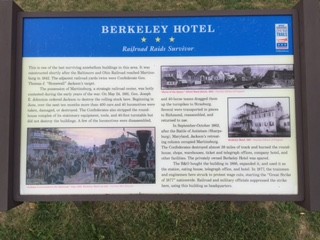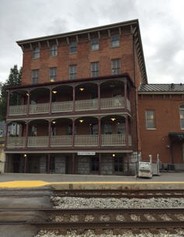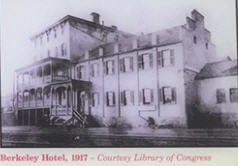Berkeley Hotel Marker
Introduction
Text-to-speech Audio
Images
Berkeley Hotel Marker: Railroad Raids Survivor, Photo by Ed Stely, September 22, 2015

The former Berkeley Hotel as it appears today. Photo by Ed Stely, September 22, 2015

Photo of the former Berkeley Hotel as it appeared in the 1860s

Backstory and Context
Text-to-speech Audio
On May 24, 1861, Confederate General Joseph E. Johnson ordered Stonewall Jackson to destroy the rolling stock here. Beginning in June, and over the next the ten months, more than 400 railcars and 40 locomotives were taken, damaged, or destroyed. The Confederates also stripped the round-house complex of its stationary equipment, tools, and 40-foot turntable but did not destroy the buildings. A few of the locomotives were disassembled, and 40-horse teams dragged them up the turnpikes to Strasburg. Several were transported in pieces to Richmond, reassembled, and returned to use.
In September-October 1862, after the Battle of Antietam (Sharpsburg), Maryland, Jackson’s retreating column occupied Martinsburg. The Confederates destroyed almost 38 miles of track and burned the round-house, shops, warehouses, ticket and telegraph offices, company hotel, and other facilities. The privately owned Berkeley Hotel was spared.
The Railroad Raids of Martinsburg, WV
As a major depot along the Baltimore and Ohio Railroad, the town of Martinsburg, Virginia (now West Virginia), enjoyed a thriving economy in the mid-1800s. For this same reason, the town of Martinsburg was a strategically desired location for both sides during the Civil War. The town changed hands between Confederate and Union forces thirty-seven times, during the course of the Civil War and was the site of two battles (First and Second Battle of Martinsburg). After the Union was defeated in the Second Battle of Bull Run on August 30, 1862, General Robert E. Lee turned his Confederate forces to the North. General Stonewall Jackson was ordered to drive the Union forces out of Martinsburg and then occupy Harper's Ferry. On the 11th of September, Jackson's men drove a force of roughly 2,500 Union troops, under the command of General Julius White, out of Martinsburg and back into Harper's Ferry.1 Between 15,000 and 20,000 Confederate soldiers converged in Martinsburg before Jackson and his men moved to capture Harper's Ferry and link up with General Lee's Army in Sharpsburg, MD.
From September 18th thru November 3rd, Martinsburg remained under Confederate control. Following the Battle of Antietam, the town of Martinsburg was converted into a major hospital center with hundreds of wounded, dying and sick soldiers being transported there for treatment. On October 19th and 20th, the Confederates resumed their efforts to destroy the property of the B&O Railroad. The engine house, warehouse, machine shops, ticket office, dining hall, wash house, coal bins and water station were all set on fire and completely destroyed. "The rails were heated to a white glow in improvised furnaces of cross ties and Confederate workers bent them around trees or stationary objects to distort their shape".1 (p. 24) Once the destruction was complete, the Confederate forces began to withdraw towards Winchester. Union forces retook control of Martinsburg on November 6, 1862 and construction crews from the B&O railroad began the enormous task of repairing the tracks and bridges. By December 25th, passenger and military trains were once again operational from Martinsburg to points west. Unfortunately for the residents of Martinsburg, their experiences with the Civil War were far from over.
